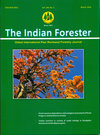Leguminosean Members:A Promising Candidates for Phytodiversity and Economic Potentialities
DOI:
https://doi.org/10.36808/if/2018/v144i3/122755Keywords:
Leguminosean Memebrs, Phytodiversity, Economic Potentiality, Kerala.Abstract
Through the present study a documentation of diverse Leguminosean members which are belonging to the families like Fabaceae, Caesalpiniaceae and Mimosaceae from different localities of Kavanur panchayath, Malappuram district, Kerala. The present results reveals that, there are about 56 species, which are belonging to 34 genera in these 3 families. The present analysis also highlights some economic potentialities of documented species such as curative efficacy, edible potentiality and other miscellaneous purposes. In addition to this, the nitrogen-fixing ability of many legumes provides an important source of biological nitrogen in agriculture and natural ecosystems.References
Anne B., Jeff J.D., Patrick H., Colin H., Greg K., Gwilym L. and Barbara M. (2013). Legume phylogeny and classification in the 21 century: Progress, prospects and lessons for other species-rich clades. Taxon., 62: 17–248.
Bruneau A., Mercure M., Lewis G.P. and Herendeen P.S. (2008). Phylogenetic patterns and diversification in the caesalpinioid legumes. Botany, 86: 697–718.
Burkart A. (1987). Leguminosas. In: Dimitri, M. Enciclopedia Argentina de Agricultura y Jardineria, Tomo I. Descripcion de plantas Cultivadas, pp 467-536, Argentina.
Gamble J.S. and Fischer C.E.C. (1936). The Flora of the Presidency of Madras, Adlard and Son Ltd., London, 1915-1936.
Herendeen P.S., Bruneau A. and Lewis G.P. (2003). Phylogenetic relationships in the caesalpinioid legumes In: A preliminary analysis based on morphological and molecular data (Bruneau A. and Klitgaard B.B. Eds.), Advances in legume systematics, Royal Botanic Garden, Kew.
Hooker J.D. (1897). The Flora of British India, Vol. I-VII. Reeve and Co., London.
Kumar S. and Sane P.V. (2003). Legumes of South Asia - A Check list, pp. 225-228, Royal Botanic Garden, Kew.
Lewis G., Schrire B., Mackinder B. and Lock M. (2005). Legumes of the World, Royal Botanic Gardens, Kew.
Mabberley D.J. (1990). The plant book, pp. 1021-1032, Cambridge University Press, Cambridge, UK.
Ratter J.A., Bridgewater S. and Ribeiro J.F. (2003). Analysis of the floristic composition of the Brazilian cerrado vegetation III: Comparison of the woody vegetation of areas. Edinb. J. Bot., 60: 57–109.
Richardson J.E., Pennington R.T. and Pennington T.D. (2001). Rapid diversification of a species-rich group of Neotropical rain forest trees. Sci., 93: 242–245.
Sanjappa M. (2003). Legumes of India, pp. 338-345, Bishen SinghMahendra Pal Singh, Dehradun.
Santapau H. and Hentry A.N. (1973). A Dictionary of the flowering plants in India. Council of Scientific and Industrial Research, pp. 138-145, New Delhi.
Sasidharan N. (2004). Biodiversity documentation for Kerala. Part-6: Flowering Plants, KeralaForest Research Institute, pp. 212-226, Peechi, Thrissur.
Simpson B.B. and Ogorzaly M.C. (1986). Economic Botany: Plants in our World, Mc Graw-Hill, New York, USA.
Vance C.P., Graham P.H. and Allan D.L. (2000). Biological nitrogen fixation. Phosphorus: a critical future need. In: Nitrogen fixation: from molecules to crop productivity, pp. 390-397, Kluwer Academic Publishers, Dordrecht, Netherlands.
Downloads
Downloads
Published
How to Cite
Issue
Section
License
Unless otherwise stated, copyright or similar rights in all materials presented on the site, including graphical images, are owned by Indian Forester.





